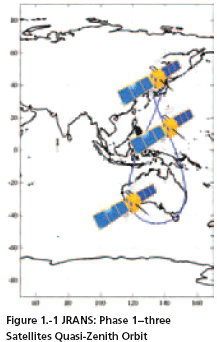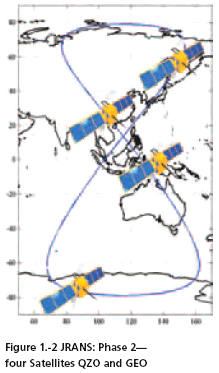| GNSS | |
A yen for regional navigation
|
||||
| In the 1970s, the US Department of Defense began GPS development as a military force enhancer. In 1983, President Reagan offered GPS civil services to the world, free of direct charges, as a result of the KAL007 disaster. This global offer sparked widespread civil use of GPS and significant investment in civil GPS technologies, to include GPS civil augmenting satellites (e.g. US Wide Area Augmentation System (WAAS), European Geostationary Navigation Overlay System (EGNOS) and the Japanese Multi-functional Transport Satellite (MTSAT)) and GPS civil user equipment to support a broad range of applications from transportation to agriculture.
From an International Civil Aviation Organization (ICAO) perspective, ICAO document A32-19 establishes and affirms the fundamental legal principles governing the use of Global Navigation Satellite Systems (GNSS) by ICAO contracting States. A key theme of A32-19 is preservation of State authority and responsibility for the provision of air navigation services in their sovereign airspace. Specific State requirements are further clarified in principle number four of A32- 19. This principle specifi cally states that: “Every State providing GNSS services…shall ensure the continuity, availability, integrity, accuracy and reliability of such services…including effective arrangements to minimize the operational impact of system malfunctions or failure and to achieve expeditious service recovery”. GPS is becoming a mainstay of everyday life in Japan; the Government Real-World IssuesCostA regional solution for meeting Japanese position, velocity and timing needs will require resources and long-term investment. The US has invested billons of dollars to design, develop and implement a GPS “system”. This investment goes well beyond building and launching satellites. The critical “brains” of GPS (the ground control segment with its Master Control Station, Monitoring Stations, Control Stations, Processors, Software, Communications, Security, etc.) assures the satellites perform and the “overall system” enables reliable position, velocity and time within SPS specifications. Then, there is the upfront and recurring cost of things that are not generally seen, such as the papers and guidance directions provided by the scientific community; development of interfaces, compatibilities, documentation, standardization, upgrades, training, etc. The other critical cost dynamic is sustaining a space-based system once it is operational. Replenishing satellites, coordinating launcher availability, schedules, risk mitigation (in the event of a launch failure), or an anomalous event causing the disruption of satellite signals. requires an enormous amount of planning, knowledge, investment and most importantly experience. Time ScaleIf Japan is going to seriously consider fielding an independent GPS-compatible system, then the system is needed as soon as possible- -not 10-15 years from now. Once again, practical experience is critical to select the best systems and subsystems, take advantage of approved standards, documentation, international guidelines, and employ proven risk mitigation techniques, etc. The net result is that the time to field an independent GPS-compatible system should be reduced. Equipment compatibilityGPS user equipment has a well established manufacturing base. Those making GPS receivers and GPS “engines” have the knowledge, experience and wherewithal to provide useable equipment. If an independent GPS-compatible Japanese system is going to be embraced and provide benefits for all users, then user equipment must be readily available and affordable. If the manufacturers have to “invent” new user equipment technology and components to accommodate a Japanese regional system, there is an established process to support the “invention” in Japan. Part of this process (particularly for aviation applications) involves the development of manufacturing standards and recommended practices. Standards and recommended practices can literally take years to develop and be accepted by the international community. Standards and recommended practices, associated research and development, testing, component design, interfaces, etc. require investment on the part of those manufacturers planning to produce user equipment. These costs will be recovered by those manufacturers producing the user equipment. The net result of an “invention requirement” for GPS-compatible Japanese user equipment: getting user equipment to the marketplace will be delayed and equipment will likely not be readily available; and GPScompatible Japanese user equipment costs will be increased–likely higher than today’s GPS equipment. OpportunitiesGPS was fully funded by the US Department of Defense (DoD) and the US Department of Transport (DoT) to satisfy position, velocity and time requirements as well as “other” military missions. The point is that the fundamental GPS ‘bus’ being used by the US DoD can accommodate additional payloads besides the navigation payload. Japanese GPS-compatible regional satellite system will not necessarily have the same requirements as the US DoD GPS satellites. This affords the opportunity to explore the inclusion of other payloads onboard the fundamental GPS ‘bus’– such as communication and weather packages. These payloads could be used to generate revenues to offset the overall cost to the GOJ for the design, development, deployment, operation and maintenance of a Japanese GPScompatible regional satellite system. OwnershipAdditional payloads and the opportunity to generate revenue, begs the question regarding who should own and operate a Japanese GPScompatible regional satellite system. The US government owns and operates GPS. However, a strong and practical argument can be made to allocate ownership and operation of a Japanese GPS-compatible regional satellite system to a commercial enterprise. This argument is essentially business based–upfront investment costs, revenue generation, return on investments and overall system sustainment. Counter arguments to the business based argument focus on States’ responsibilities, and subsequent liabilities as well as continuity of the commercial enterprise. For instance, should a Japanese GPS-compatible regional satellite system be used to support aviation navigation, then principle number four of A32- 19 (described earlier) applies. However, it is quite possible that a cooperative government-industry arrangement could be established in order to accommodate Japanese government responsibilities for assuring GNSS services while offsetting government spending by taking advantage of commercial investments. OptionsReal-world issues as highlighted in the previous section have established a path for the Japanese decision makers to follow when formulating an approach for developing a GPScompatible Regional Satellite System capable of serving Japan as well as all of Asia. The significance and importance of these issues such as: • Cost: initial and longterm commitments • Time: GPS is here today– we need an independent and complementary system now • Compatibility: GPS is being used today, more of the same is better and smarter • Opportunities: GPS is a bus– it can carry other payloads • Ownership: government, industry or both–it is a questionwere viewed differently by Japanese government and industry representatives. These differences of opinion had a positive effect because they resulted in several program options for a Japanese GPScompatible regional satellite system. In the end, these options provided a basis for moving forward with a comprehensive Japanese program. A brief overview of two viable options will be provided prior to discussing the current status of the Japanese program. Option A: Japanese Regional Navigation Satellite System (JRANS)In September 2000, the JRANS concept was developed by a Japanese industry partnership of ITOCHU Corporation, NEC Corporation and TOSHIBA Corporation. JRANS conceptual briefings were provided to several Japanese government representatives as well as US government and industry personnel working with GPS. Based on the positive feedback from these initial briefi ngs, ITOCHU and NEC TOSHIBA Space Systems, Ltd. (“NTSpace”, a joint venture between NEC and TOSHIBA formed in April 2001 to merge their respective space business) continued working and discussing the JRANS concept with Japanese and US government and industry personnel. The JRANS concept and developmental approach was further refined to satisfy current and future operational requirements and assure full compatibility and interoperability with GPS. Highlights of the JRANS concept are: • Fully complementary, interoperability and compatibility with GPS • Capable of autonomous navigation and complementary / regional backup for GPS • Satellite coverage will be regional (i.e. over Asia, see figure 1.) • Free of direct user charges (like GPS) • Private sector can participate and provide commercial servic The proposed JRANS program is atwo-phase build-up of quasi-zenith orbit (QZO), then another quasi-zenith and geostationary orbiting satellites (QZO and GEO), see figure 1. For a satellite navigation receiver to calculate a solution, four satellite signals in view with good geometry must be received to determine latitude, longitude, altitude and time. Satellite signals are “line-of sight” transmissions and can be easily blocked by high terrain, buildings, etc. This blocking of the signals is referred to as masking. Use of GPS in Japan can be difficult because of this masking situation. Natural geographic features, such as mountainous terrain and manmade features, such as tall buildings often render GPS services unavailable in the most critical of situations. The advantage of a fully populated (7 satellite) constellation is having four satellites in view, at high mask angles, broadcasting GPS-type information, being controlled by Japan, and in coordination with the U.S. under the bilateral security treaty. Having four Japanese GPScompatible satellites in view at higher elevations is particularly beneficial for those operating in mountainous areas and “urban canyons”, as illustrated by Figure 2: For GNSS users in Asia, there will also be a significant improvement in overall end state user performance as a result of better geometric dilution of precision (GDOP). Recall, GDOP is all geometric factors that degrade the accuracy of position fixes derived from externally referenced navigation systems. Specifi cally, for a user in Tokyo Japan, using only GPS, the GDOP for a 10 degree mask angle is 2.39; the GDOP for a 30 degree mask angle is 6.88. That same user, at the same location, using GPS and JRANS together would have a GDOP of 1.80 at a 10 degree mask angle and a GDOP of 3.59 with a 30 degree mask angle. Given that a 30 degree mask angle is typical for Japanese urban areas (Figure 2), the improvement (from a GDOP of 6.88 with GPS only to 3.59 with GPS and JRANS) will improve the overall performance accuracy thereby increasing the utility of satellitebased position, velocity and time. When one takes into consideration both JRANS signals and GPS signals, the combined benefits for an end state user–in terms of available satellite signals–are quite signifi cant, as illustrated in Figure 5: |
||||
Pages: 1 2














 (No Ratings Yet)
(No Ratings Yet)



